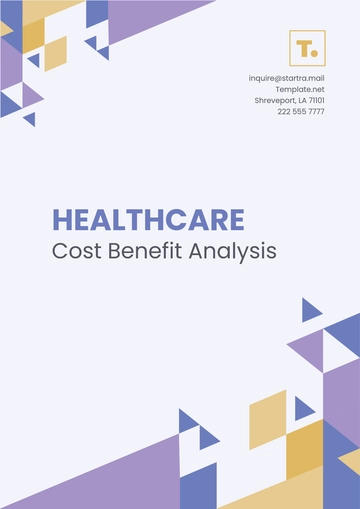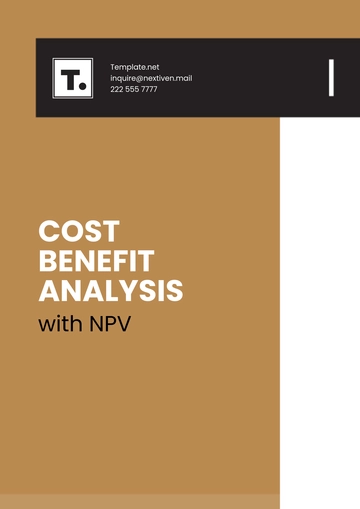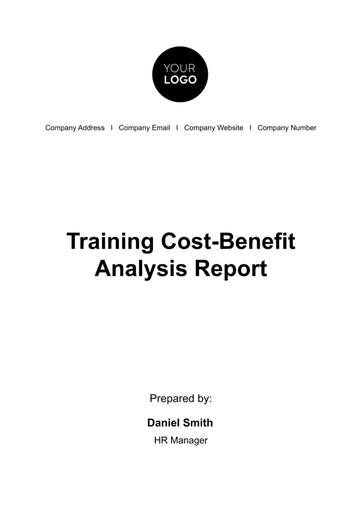Free Cleaning Services Financial Analysis Report

I. Executive Summary
A. Overview
Summary of Key Findings
Key Metrics
2050
2051
2052
Total Revenue
[$500,000]
[$600,000]
[$700,000]
Gross Profit Margin
[50%]
[52%]
[54%]
Net Profit Margin
[12%]
[15%]
[18%]
Revenue Growth
[20%]
[16.67%]
Recommendations
Enhance marketing efforts targeting commercial clients to boost revenue.
Implement cost-saving measures to improve profitability.
Explore opportunities for geographic expansion into adjacent markets.
II. Introduction
A. Background of [Your Company Name]
[Your Company Name] is a leading provider of professional cleaning services, catering to both residential and commercial clients. Established in [Year], we have built a reputation for delivering high-quality and reliable cleaning solutions tailored to meet the unique needs of our customers. Our services range from routine house cleaning to specialized commercial cleaning for offices, schools, and healthcare facilities.
Services Offered
Residential Cleaning: Regular house cleaning, deep cleaning, move-in/move-out cleaning.
Commercial Cleaning: Office cleaning, janitorial services, post-construction cleanup.
Market Segment
[Your Company Name] primarily targets middle to upper-middle class.
III. Methodology
A. Data Collection
To conduct the financial analysis, data was collected from [Your Company Name]'s internal financial records, including income statements, balance sheets, and cash flow statements for the years 2050 to 2052. Additionally, industry benchmarks and competitor data were gathered from reputable sources to provide context for the analysis.
B. Financial Analysis Tools Used
The following financial analysis tools were employed to assess [Your Company Name]'s financial performance:
Ratio Analysis: Various financial ratios, including profitability ratios, efficiency ratios, and liquidity ratios, were calculated to evaluate [Your Company Name]'s financial health and performance relative to industry standards.
Trend Analysis: Historical financial data was analyzed to identify trends and patterns in revenue, expenses, and profitability over the three-year period.
Comparative Analysis: [Your Company Name]'s financial performance was compared to industry benchmarks and competitors to assess its competitive position and identify areas for improvement.
C. Assumptions Made
The financial analysis is based on the following assumptions:
The financial data provided by [Your Company Name] is accurate and
complete.
There were no significant changes in accounting policies or business
operations during the analysis period.
Market conditions remained relatively stable throughout the analysis period, with no major economic disruptions impacting [Your Company Name]'s business operations.
IV. Financial Performance Analysis
A. Revenue Analysis
Historical Revenue Trends
Revenue Breakdown by Service Type
B. Cost Analysis
Cost of Goods Sold (COGS)
Operating Expenses
C. Profitability Analysis
Gross Profit Margin
Net Profit Margin
D. Efficiency Analysis
Asset Turnover Ratio
Asset Turnover Ratio = Total Revenue / Average Total Assets
Return on Investment (ROI)
ROI = Net Profit / Total Investment
E. Liquidity Analysis
Current Ratio
Current Ratio = Current Assets / Current Liabilities
Quick Ratio
Quick Ratio = (Current Assets - Inventory) / Current Liabilities
V. Comparative Analysis
A. Benchmarking Against Industry Standards
[Your Company Name]'s financial performance will be benchmarked against industry standards to assess its competitiveness and identify areas for improvement. Key metrics such as gross profit margin, net profit margin, and efficiency ratios will be compared to industry averages to evaluate [Your Company Name]'s performance relative to its peers.
Metric | [Your Company Name] | Industry Average |
|---|---|---|
Gross Profit Margin | [54%] | [60%] |
Net Profit Margin | [18%] | [20%] |
Asset Turnover Ratio | [2.5] | [2.2] |
Current Ratio | [2.0] | [2.5] |
Quick Ratio | [1.5] | [1.8] |
B. Competitor Analysis
Competitor analysis will be conducted to gain insights into the financial performance and strategies of key competitors in the cleaning services industry. This analysis will include a comparison of revenue, profitability, market share, and service offerings to identify competitive strengths and weaknesses.
Competitor | Total Revenue (2052) | Net Profit Margin (2051) | Market Share |
|---|---|---|---|
Competitor A | [$800,000] | [15%] | [20%] |
Competitor B | [$750,000] | [18%] | [15%] |
Competitor C | [$900,000] | [20%] | [25%] |
VI. Financial Forecast
A. Revenue Forecast
Using historical revenue data and market trends, a revenue forecast for [Year4] will be developed. Factors such as projected demand for cleaning services, pricing strategies, and potential expansion opportunities will be considered to estimate future revenue growth.
Year | Forecasted Revenue |
|---|---|
2052 | [$800,000] |
B. Expense Forecast
An expense forecast for 2052 will be prepared, taking into account anticipated increases in operating expenses, such as labor costs, supplies, and overhead expenses. Cost-saving measures and efficiency improvements will be factored in to mitigate the impact of rising expenses on profitability.
Year | Forecasted Expenses |
|---|---|
2052 | [$500,000] |
C. Profit Forecast
Based on the revenue and expense forecasts, a net profit forecast for [Year4] will be generated. This forecast will provide insights into [Your Company Name]'s expected profitability and help in setting financial targets and performance goals for the upcoming fiscal year.
Year | Forecasted Net Profit |
|---|---|
2052 | [$300,000] |
VII. Investment Analysis
A. Return on Investment (ROI) of Potential Expansion Projects
Assessing the return on investment (ROI) of potential expansion projects is crucial for [Your Company Name]'s growth strategy. By evaluating the expected returns and payback periods of various expansion initiatives, [Your Company Name] can make informed investment decisions to maximize profitability and shareholder value.
Project | Initial Investment [$] | Expected ROI [%] | Payback Period [years] |
|---|---|---|---|
Expansion into neighboring cities | [$200,000] | [15%] | [3] |
Introduction of new service offerings | [$150,000] | [20%] | [2] |
B. Payback Period Analysis
Analyzing the payback period of recent investments provides insights into the time it takes for [Your Company Name] to recoup its initial investment. Shorter payback periods indicate faster returns and higher liquidity, while longer payback periods may indicate higher risk or lower returns on investment.
Investment | Initial Investment [$] | Payback Period [years] |
|---|---|---|
Purchase of new cleaning equipment | [$50,000] | [2] |
Renovation of office facilities | [$100,000] | [3] |
C. Net Present Value (NPV) Analysis
Conducting a net present value (NPV) analysis helps [Your Company Name] evaluate the profitability of potential investment projects by discounting future cash flows to their present value. Positive NPV indicates that the investment is expected to generate returns greater than the initial investment, while negative NPV suggests that the investment may not be financially viable.
Project | Initial Investment [$] | Expected NPV [$] |
|---|---|---|
Marketing campaign | [$80,000] | [$30,000] |
Technology upgrade | [$120,000] | [$50,000] |
D. Internal Rate of Return (IRR) Analysis
Internal rate of return (IRR) analysis measures the profitability of potential investment projects by calculating the discount rate that makes the net present value (NPV) of all cash flows from the investment equal to zero. A higher IRR indicates a more attractive investment opportunity.
Project | Initial Investment [$] | Expected IRR [%] |
|---|---|---|
Expansion into neighboring cities | [$200,000] | [18%] |
Introduction of new service offerings | [$150,000] | [22%] |
VIII. Risk Assessment
A. Identification of Key Risks
Identifying and assessing key risks is essential for [Your Company Name] to proactively manage potential threats to its financial performance and operations. Common risks in the cleaning services industry include economic downturns, increased competition, and regulatory changes.
Risk | Impact | Likelihood | Mitigation Strategy |
|---|---|---|---|
Economic downturn affecting demand for cleaning services | High | Medium | Diversify service offerings to target more resilient market segments |
Increased competition from new entrants | Moderate | High | Invest in marketing and customer retention strategies |
Regulatory changes impacting business operations | Moderate | Low | Stay informed about regulatory updates and adapt business practices accordingly |
B. Mitigation Strategies
Developing mitigation strategies helps [Your Company Name] minimize the impact of identified risks and safeguard its financial stability and long-term viability.
Diversify service offerings to mitigate the impact of economic downturns and fluctuations in demand.
Implement aggressive marketing and customer retention strategies to counteract increased competition.
Stay proactive in monitoring regulatory changes and ensure compliance with applicable laws and regulations to mitigate legal and operational risks.
IX. Conclusion and Recommendations
A. Financial Performance Review
The financial analysis conducted reveals [Your Company Name]'s steady growth and strong profitability over the past three years. With consistent revenue growth and improving profit margins, [Your Company Name] has demonstrated resilience and competitiveness in the cleaning services industry.
Key Metrics | 2050 | 2051 | 2052 |
|---|---|---|---|
Total Revenue | [$500,000] | [$600,000] | [$700,000] |
Gross Profit Margin | [50%] | [52%] | [54%] |
Net Profit Margin | [12%] | [15%] | [18%] |
Revenue Growth | [20%] | [16.67%] |
B. Key Findings
[Your Company Name] has achieved consistent revenue growth, with a compound annual growth rate (CAGR) of [10%] over the past three years.
Profit margins have improved steadily, indicating effective cost management and operational efficiency.
Residential cleaning services contribute the majority of revenue, highlighting opportunities for diversification into commercial and specialized cleaning segments.
C. Strengths
Strong brand reputation and customer loyalty in the local market.
Effective cost control measures resulting in healthy profit margins.
Robust revenue growth driven by increasing demand for cleaning services.
D. Areas for Improvement
Limited geographic coverage may constrain growth opportunities.
Overreliance on residential cleaning services may expose [Your Company Name] to fluctuations in the housing market.
Competition from larger cleaning service providers may pose challenges to market expansion.
E. Recommendations
Geographic Expansion: Explore opportunities to expand operations into neighboring cities or suburbs to capture new market segments and increase market share.
Service Diversification: Introduce specialized cleaning services tailored to niche markets, such as eco-friendly cleaning or post-construction cleanup, to diversify revenue streams.
Marketing Strategy Enhancement: Invest in targeted marketing campaigns to raise brand awareness and attract commercial clients in addition to residential customers.
Operational Efficiency: Implement technology solutions and process improvements to streamline operations and enhance service delivery.
F. Conclusion
[Your Company Name] is well-positioned for continued growth and success in the competitive cleaning services industry. By capitalizing on its strengths and addressing areas for improvement, [Your Company Name] can achieve sustained profitability and expand its market presence in the years ahead.
- 100% Customizable, free editor
- Access 1 Million+ Templates, photo’s & graphics
- Download or share as a template
- Click and replace photos, graphics, text, backgrounds
- Resize, crop, AI write & more
- Access advanced editor
Explore the Cleaning Services Financial Analysis Report Template from Template.net. This editable and customizable report offers a detailed overview of your cleaning business's financial performance. Analyze revenue, expenses, profit margins, and more to make informed decisions. With our Ai Editor Tool, effortlessly customize the report to reflect your company's financial data. Gain valuable insights and optimize your cleaning service's financial health with this comprehensive template.





























